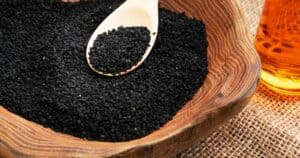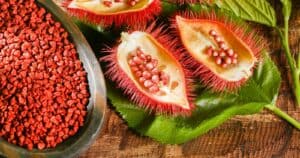Are you tired of cooking the same old dishes and want to add freshness to your meals? Look no further than mint, the versatile herb that can add flavor and health benefits to your kitchen.
Mint has been used for centuries for its refreshing and cooling taste, but did you know it can also aid digestion and alleviate headaches? In this article, we will explore the many benefits of mint and how to use it in your cooking and baking.
First, let’s dive into the basics of mint. There are various types of mint, each with its distinct flavor profile. Peppermint, spearmint, and chocolate mint are the most common types and can be used in multiple dishes.
Mint can be fresh or dried in most grocery stores, making it easily accessible for all home cooks. Additionally, growing it in a garden or container is easy and can provide fresh mint for meals year-round.
From teas to desserts and savory dishes, mint is a versatile herb that can enhance the flavor and freshness of any word. Next, we will explore the many uses of mint in cooking and baking. We’ll also touch on the health benefits of mint, including its anti-inflammatory and antispasmodic properties, making it a valuable ingredient in traditional medicine.
The Basics of Mint: Types and Accessibility
Mint is a popular and versatile plant with wide different varieties. You can find mint plants that are spearmint, peppermint, licorice, apple, pineapple, orange, chocolate, ginger, or yerba buena flavored.
With its invasive nature, it can grow up to 3 feet tall and is easy to grow in gardens and containers. It’s accessible to anyone with a backyard or just a windowsill.
You can have fresh mint on hand for culinary, medicinal, or decorative purposes with the proper care.
If you’re looking to plant mint, it’s essential to know that it grows best in full sun to partial shade. It prefers moist soil and should be watered regularly.
To verify that you have a mint plant, just rub the stem, and you’ll feel its square shape. While all mints have this feature, each variety has its unique flavor profile and aromatic characteristics.
- Spearmint is easily the most well-known type of mint, with its distinctive minty fresh taste. Peppermint has a more robust flavor and can often be found in tea form.
- Curly mint is known for its crinkly leaves, which can add texture to various dishes.
- Licorice mint is native to Mediterranean regions and has a sweet, anise-like flavor. Apple mint has a fruity taste, while pineapple and orange mints have tropical notes.
- Chocolate mint has a cocoa fragrance, and ginger mint has a spicy kick. Yerba buena is a mint variety with a mild, minty flavor often used in Filipino and Latin American cuisine.
Cooking with Mint: Versatility and Uses in Dishes
Cooking with mint is versatile and delicious. Mint can be used in sweet and savory dishes, making it a popular ingredient in many kitchens. The fresh coolness of mint adds a refreshing touch to drinks, desserts, and salads. Its use in pesto is a classic example of the herb’s versatility.
Using mint in cooking is easy, whether it is eaten raw or cooked. The herb’s ability to liven up dishes with its distinct flavor makes it an ideal ingredient to incorporate into many recipes.
One of the most popular uses of this herb is tea. Adding freshly picked mint leaves to hot water creates a delicious and soothing tea.
Mint can be used in various dishes, from Greek salads to Moroccan stews to Italian sauces. Its use in desserts like chocolate mint chip ice cream or mint chocolate chip cookies adds a unique flavor and refreshing taste.
It pairs well with multiple ingredients, such as cucumber, lemon, lamb, and even chocolate, making it one of the most versatile herbs.
Baking with Mint: Adding Flavor to Desserts
Mint is a versatile herb that can add a refreshing twist to your desserts. Mint can make flavor cakes, cookies, brownies, and milkshakes. Creaming chopped mint with butter or oil infuses the herb’s flavor into your dessert.
Some recipes can add fresh mint leaves directly to the batter or dough. When working with fresh mint, make sure to chop only the leaves and avoid the stems, as they can lend an unpleasant texture to your baked goods.
The refreshing flavor of mint complements the richness of chocolate and creates a delicious balance of flavors. Mint pairs well with chocolate in many desserts such as mint chocolate chip cookies, brownies, and cakes.
Mint frosting can also be used to top cakes and cupcakes. Simply add fresh mint leaves to a basic frosting recipe, and you’ll have a tasty and unique frosting in no time.
For a healthy dessert option, try making mint fruit salad. Cut up your favorite fruits and mix them with chopped mint leaves. This dessert is not only refreshing, but it’s also packed with vitamins and nutrients.
Mint can also be used in milkshakes to create a fun and festive twist on this classic treat. Add fresh mint leaves to your milkshake mixture for a refreshing and excellent flavor. You can also add chocolate chips or other toppings for extra flavor.
Health Benefits of Mint: Anti-Inflammatory and Antispasmodic Properties
Mint may be a small herb, but its health benefits are impressive. Mint can do wonders for your body thanks to its anti-inflammatory and antispasmodic properties.
The rosmarinic acid in mint helps reduce inflammation, making it an excellent addition to an anti-inflammatory diet.
Additionally, the antibacterial, antiviral, and anti-inflammatory properties found in peppermint can come in handy for treating clogged sinuses due to infections. With all its goodness, it’s no surprise that mint is a top choice for maintaining good health.
Adding mint to your diet can make all the difference if you struggle with digestion. Mint has essential oils that help enzymes digest food, making it an excellent digestive aid.
This herb also eases muscle cramping due to its antispasmodic properties, which are beneficial for conditions such as irritable bowel syndrome.
In addition, peppermint oil can have anti-inflammatory effects on immune cells, reducing inflammation in the body. With mint on your side, you can address various health issues with ease.
Recipes to Try: Mint Tea, Mint Salad Dressing, and more
Are you looking for new recipes to try? Mint is a versatile herb that can be used in various dishes. Let’s dive into some recipes you can make using mint:
Mint Salad Dressing: Whisk together fresh mint, lemon juice, olive oil, Dijon mustard, and honey or maple syrup to create a refreshing and easy-to-make salad dressing. It’s perfect for a summer day!
Mint Tea: Love tea? Make some mint tea by steeping fresh mint leaves in boiling water for a few minutes. It’s a great way to relax and has various health benefits.
Mint Vinaigrette: Mix chopped fresh mint with lemon juice, extra-virgin olive oil, red wine vinegar, honey or maple syrup, and salt to create a flavorful vinaigrette. It’s perfect for drizzling over a salad or roasted vegetables.
Yogurt Mint Salad Dressing: Mix plain whole milk yogurt, lemon juice or small shallot garlic clove, and fresh mint leaves for a creamy yogurt-based dressing perfect for a summer salad.
Basil-Mint Dressing: Combine fresh basil leaves along with fresh mint leaves with the garlic clove (or small shallot), salt, and pepper to taste. Add zest from one lemon along with its juice. Mix in honey or maple syrup to balance the flavors. It’s a delicious dressing perfect for a tomato and mozzarella salad.
Mint Tea Salad: Create an earthy salad by combining sunflower oil, olive oil, apple cider vinegar, dijon mustard, shallots, and fresh mint. It’s a refreshing salad perfect for a light lunch or dinner.
Mint Substitute
Mint substitution is common in cooking, and fortunately, many options are available. If you’re wondering about a substitute for mint, here’s good news: you can use basil, marjoram, parsley, rosemary, tarragon, cilantro, peppermint extract, or even lemon balm.
There are many options to choose from, and your decision will depend on the recipe.
Let’s take a closer look at the substitutes for mint.
- Basil: This herb has a sweet, slightly peppery flavor and aroma that works well with tomato-based dishes, salads, and pesto sauce.
- Rosemary: This woody herb has a pine-like scent and flavor that pairs well with lamb, poultry, and vegetables. Use it sparingly, though, as its powerful aroma can take over the dish.
- Tarragon: This herb has a mild licorice flavor, making it ideal for seasoning chicken, fish, and eggs. It’s also a primary ingredient in French cuisine.
- Lemon Balm: As the name suggests, this herb has a lemony flavor and is perfect for teas or desserts. It works well as a substitute for mint in cocktails or other drinks.
There are other options available, too, so feel free to experiment and discover what works best for you. The key is to find a substitute that complements the dish without overpowering the other flavors.
But what about the dishes that specifically call for mint? Can you still substitute it? Yes, you can. Here are some recipes in that you can use the mint substitutes:
- Tabbouleh salad: If you don’t have fresh mint, you can use parsley, cilantro, or a combination of the two.
- Mint tea: Lemon balm or even a drop of peppermint extract can be used to make tea as an alternative to fresh mint leaves.
- Mint brownies or ice cream: Peppermint extract can provide a similar flavor to fresh mint in desserts.





